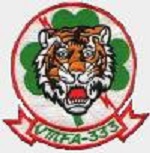Hobby Master HA3519 USMC Boeing F/A-18A+ Hornet Strike Fighter - VMFA-333 "Fighting Shamrocks", Late 1980s [Low-Vis Scheme] (1:72 Scale)
"Bigger, Higher, Faster, Farther."
- Thinking within the US Air Force during the late 1970s
 The F/A-18 Hornet is the true multi-role aircraft. It can vault from a carrier deck, bomb a target and stay to dogfight even the best enemy aircraft without missing a beat. It's the Navy's first modern-era jet intended for double duty against air- and ground-based adversaries. Armed to the hilt with Sparrow and Sidewinder air-to-air missiles, an internal cannon, and laser-guided bombs, this modern warbird was an outstanding performer in Operation Desert Storm. Strapped into a digital cockpit described as a cross between Star Wars and a video game, pilots of the F/A-18 Hornet take on the ultimate aviation job: blasting this single-seat, high-performance jet off the deck of a carrier, dropping bombs, and firing air-to-ground ordnance. Offering unmatched agility, the Hornet is the choice aircraft of the US Navy's elite Blue Angels aerobatic team.
The F/A-18 Hornet is the true multi-role aircraft. It can vault from a carrier deck, bomb a target and stay to dogfight even the best enemy aircraft without missing a beat. It's the Navy's first modern-era jet intended for double duty against air- and ground-based adversaries. Armed to the hilt with Sparrow and Sidewinder air-to-air missiles, an internal cannon, and laser-guided bombs, this modern warbird was an outstanding performer in Operation Desert Storm. Strapped into a digital cockpit described as a cross between Star Wars and a video game, pilots of the F/A-18 Hornet take on the ultimate aviation job: blasting this single-seat, high-performance jet off the deck of a carrier, dropping bombs, and firing air-to-ground ordnance. Offering unmatched agility, the Hornet is the choice aircraft of the US Navy's elite Blue Angels aerobatic team.
The F/A-18A is the single-seat variant and the F/A-18B is the two-seat variant. The space for the two-seat cockpit is provided by a relocation of avionics equipment and a 6% reduction in internal fuel; two-seat Hornets are otherwise fully combat-capable. The B-model is used primarily for training.
In 1992, the original Hughes AN/APG-65 radar was replaced with the Hughes (now Raytheon) AN/APG-73, a faster and more capable radar. A-model Hornets that have been upgraded to the AN/APG-73 are designated F/A-18A+.
Pictured here is a gorgeous 1:72 scale diecast replica of a USMC Boeing F/A-18A+ Hornet Strike Fighter that was attached to VMFA-333 Fighting Shamrocks during the late 1980s.
Sold Out!
Dimensions:
Wingspan: 7-1/2-inches
Length: 9-inches
Release Date: December 2014
 Historical Account: "Fighting Shamrocks" - Marine Fighter Attack Squadron 333 (VMFA-333) was a United States Marine Corps fighter squadron consisting of F/A-18 Hornets. Known as the "Fighting Shamrocks" and "Trip Trey", the squadron participated in action during World War II, the Vietnam War and Operation Desert Storm The squadron's aircraft were easily recognizable by the row of three shamrocks painted on the vertical stabilizers of their aircraft. They were decommissioned on March 31st, 1992.
Historical Account: "Fighting Shamrocks" - Marine Fighter Attack Squadron 333 (VMFA-333) was a United States Marine Corps fighter squadron consisting of F/A-18 Hornets. Known as the "Fighting Shamrocks" and "Trip Trey", the squadron participated in action during World War II, the Vietnam War and Operation Desert Storm The squadron's aircraft were easily recognizable by the row of three shamrocks painted on the vertical stabilizers of their aircraft. They were decommissioned on March 31st, 1992.








